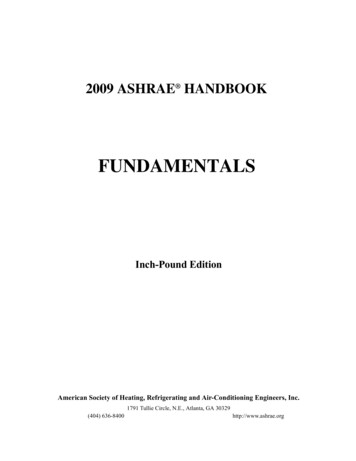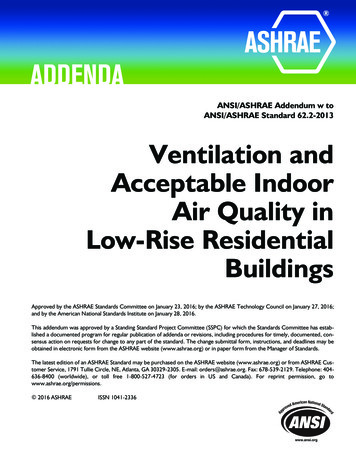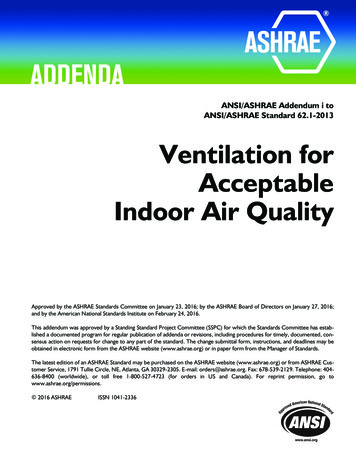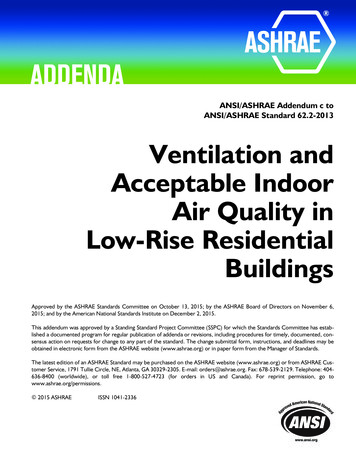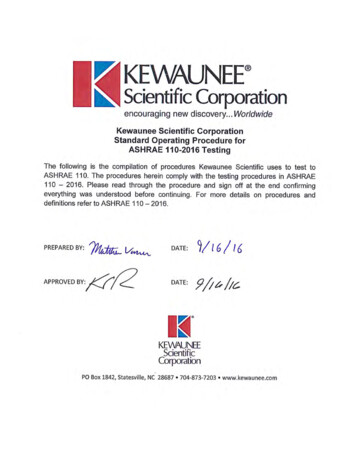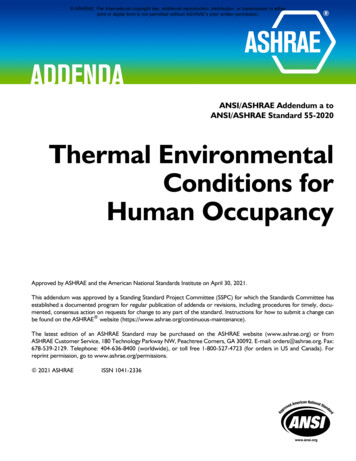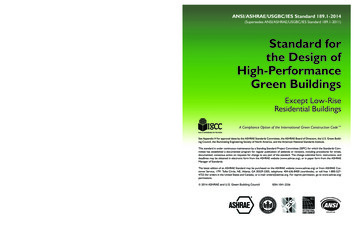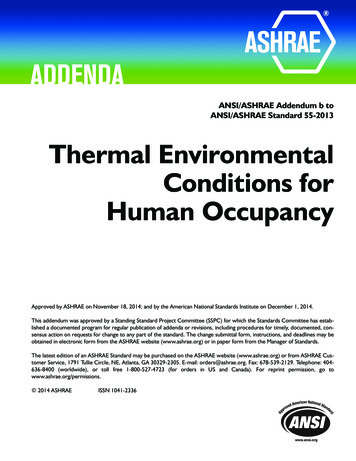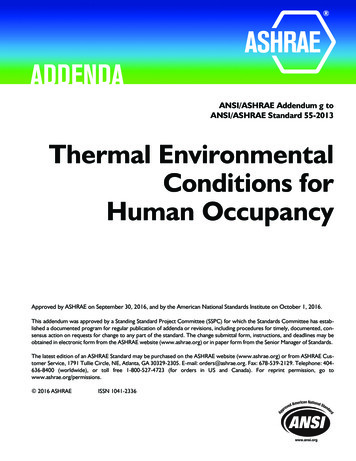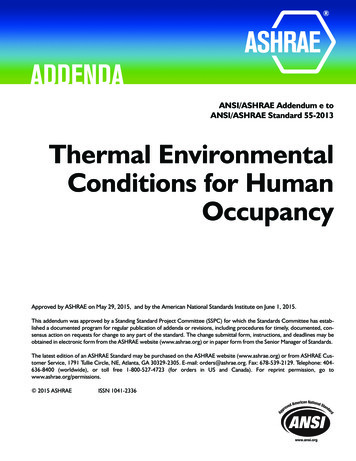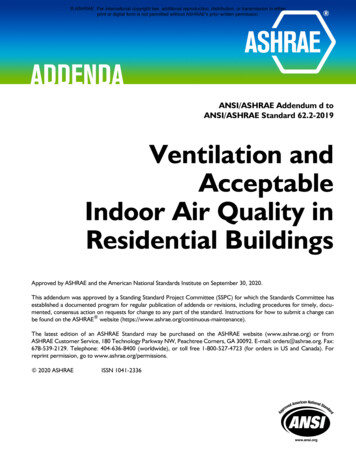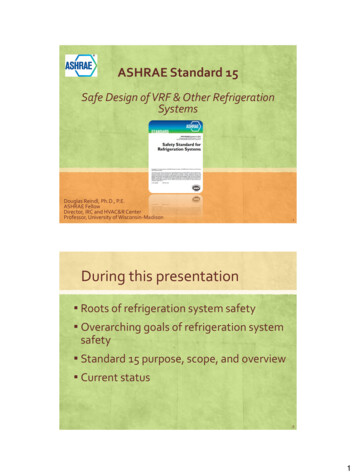
Transcription
ASHRAE Standard 15Safe Design of VRF & Other RefrigerationSystemsDouglas Reindl, Ph.D., P.E.ASHRAE FellowDirector, IRC and HVAC&R CenterProfessor, University of Wisconsin-Madison1During this presentation Roots of refrigeration system safety Overarching goals of refrigeration systemsafety Standard 15 purpose, scope, and overview Current status21
A bit of history,1914 1919193219391950 1953 195819641971Refrigeration System Safety TimelineCode expands toregulaterefrigeratingmachines &refrigerantsASRE engineersinitiatedevelopment of1st refrigerationsafety code forNYCASRE publishesupdated versions ofASA B9ASRE publishes andASA approves B9 the“American StandardSafety Code for Mech.Refrigeration”ASRE redesignatesB9 to B9.1publishingupdatedversions.Merger ofASRE andASHAEleadsASHRAE topublish asB9.1ANSIapprovesASHRAEB9.13A bit of history,19781989 1992 199420012004200720102013Refrigeration System Safety TimelineASHRAE publishes1st version ofANSI/ASHRAE 15ASHRAE publishes revisedversions of ANSI/ASHRAEStandard 1542
ASHRAE 15 today Purpose: specifies safe design, construction,installation, and operation of refrigerationsystems Scope: establishes safeguards for life, limb,health, and property and prescribes safetyrequirements5Fundamental goals of Std. 151. Keep refrigerants contained within thesystem2. In the event when a refrigerant might bereleased, mitigate its impact on peoplea) By limiting refrigerant quantity in direct systemsb) Locating refrigeration systems within machineryrooms when system charge is too large63
ASHRAE 15 Applications:a) design, construction, test, installation, operation,and inspection of mechanical and absorptionrefrigeration systems, including heat-pump systemsused in stationary applications;b) modifications, including replacement of parts orcomponents if they are not identical in function andcapacity; andc) refrigerant substitutions with a different designation7ASHRAE 34 Companion to ASHRAE 15Purpose: establish a system to uniquelyidentify refrigerants, assign reference numbersto refrigerants, establishes safety classificationand refrigerant concentration limits84
ASHRAE 15 and ASHRAE 34 ASHRAE 15 defers to ASHRAE 34 on: Refrigerant safety classifications Refrigerant concentration limits (RCLs) Key refrigerant property information that mustbe submitted with an application for designation9ASHRAE 34105
ASHRAE 34 Toxicity classifications Class A signifies refrigerants where toxicity hasnot been identified at concentrations 400 ppmvbased on TLV–TWA data or consistent indices Class B signifies refrigerants for where there isevidence of toxicity at concentrations 400 ppm,based on TLV-TWA data or other consistentindices11ASHRAE 34 Flammability classifications1 – No flame propagation2 – Exhibits flame propagation, a LFL 0.10 kg/m3and heat of combustion 19,000 kJ/kg2L – burning velocity not greater than 10 cm/s*3 – Exhibits flame propagation, a LFL 0.10 kg/m3and heat of combustion 19,000 kJ/kg* per ASTM E 681126
ASHRAE 34 Refrigerant safety classifications A1 R22, R134a A2L R32, R143a, R1234yf B2L R717 (ammonia) A3 R600a (isobutane),Safety Group o FlamePropagationR290 cityThe 2L refrigerants have a burning velocity of 10 cm/s or slower.13Standard 15 content Classifications Section 4 – Occupancy Section 5 – Refrigerating systems Section 6 – Refrigerant safety147
Standard 15 content Restrictions Section 7 – Refrigerant use Section 8 – Installation Design, construction, & operation Section 9 – Equipment and Systems Section 10 – Operation and testing15Standard 15 content General Section 11 – General requirements Section 12 – Precedence with conflicts Section 13 – Listed equipment Normative appendices Appendix B – References Appendix D – Relief vent line lengths168
Restrictions on useI. Determine refrigerant concentration fromcomplete discharge of largest independentrefrigerant circuitII. Resulting concentration cannot exceed therefrigerant’s RCL from ASHRAE 34(institutional occupancies @ 50% of RCL)Exceptions:1. Listed equipment not containing more than 6.6 lb.2. Listed equipment for use in laboratories with more than 100 ft2/person20What is RCL? ASHRAE 34 RCL is the refrigerant concentration limit in air thatis intended to reduce the risks of acute toxicity,asphyxiation, and flammability hazards in normallyoccupied, enclosed spaces Concentration is based on full vaporization of the refrigerant in the space towhich it is released with complete mixing and noremoval by ventilation, dissolution, reaction, ordecomposition229
ASHRAE 34 RCL excerpt23Volume for determining RC Volume of space to which refrigerant disperses inthe event of a refrigerant leak [§7.3] Occupied spaces that do not connect throughpermanent openings or HVAC ducts, use the volume ofthe smallest occupied space [§7.3.1] When refrigerant is in an air-handler, duct, or spaceserved by mechanical ventilation, the entire airdistribution system must be analyzed2410
What are some refrigeration safetyimplications for VRF systems? Ensure space(s) served do not exceed RCL Avoid prohibited locations of refrigerantpiping [8.10.2] Refrigerant piping shall not be placed in any shaft that has openings to living quarters means of egress enclosed public stairway or stair landing25Example 1 Background Building has VRF with indoor units in avariety of locations (ceiling, wall, or floor) todirectly condition the occupied space Facility includes a separate DOAS withducted supply of OA and plenum return DOAS system does not operate continuouslyMarch 5, 20152611
Example 1 Background, cont. VRF terminal units take air from conditionedspace and return air to condition (notconnected directly to plenum or DOAS ducts) Because VRF units are not located in thesupply ductwork or return plenum,refrigerant could leak directly into spaceMarch 5, 201527Example 1 – tentative interpretation7.3.2.3 Supply and Return Ducts. Thevolume of the supply and return ducts andplenums shall be included when calculating therefrigerant quantity limit in the system. The volume of the supply ducts and return plenumcan be used in the RCL calculation even if thepotential for refrigerant leaks are not located inthe ducts/plenums?Is this interpretation correct?March 5, 20152812
ASHRAE 15 – InterpretationMarch 5, 201529Example 2 - BackgroundJune 24, 2012 3013
Example 2 – Background The definition of “permanent openings”is a major consideration in theapplication of Section 7.3.131ASHRAE 15-2010 7.3.1 Nonconnecting Spaces. Where a refrigeratingsystem or a part thereof is located in one or moreenclosed occupied spaces that do not connectthrough permanent openings or HVAC ducts, thevolume of the smallest occupied space shall beused to determine the refrigerant quantity limit inthe system.Where different stories and floor levels connectthrough an open atrium or mezzanine arrangement,the volume to be used in calculating the refrigerantquantity limit shall be determined by multiplying thefloor area of the lowest space by 8.2 ft (2.5 m).June 24, 20123214
Example 2 – tentative interpretation Undercut doors and/or transfer grilles (if largeenough) located near the floor constitute“permanent openings”.Is this interpretation correct?33ASHRAE 15 – InterpretationJune 24, 20123415
Example 3 – Background Hotel/motel guest rooms typically consist of asleeping room and connected toilet room. VRF systems applied to guest rooms havepotential to discharge large quantities ofrefrigerant into the guest room Greatest risk for life safety occurs when guestsare sleeping and their location is within thebottom 3 ft of the guest room where heavier thanair refrigerant would collect.June 27, 201035Example 3 – tentative interpretation It is Hilton Worldwide’s interpretation thatthe volume calculations should onlyinclude the lowest volume of the roomwhich the guest is supine and sleepingwhen determining allowable refrigerantlimits.Is this interpretation correct?June 27, 20103616
ASHRAE 15 – InterpretationJune 27, 201037Example 4 - BackgroundJanuary 30, 20113817
ASHRAE 15 – InterpretationJanuary 30, 201139A machinery room required when,a. the quantity of refrigerant exceeds the limits fora given occupancyb. direct-fired absorption equipment is usedWhen required, all refrigerant-containingcomponents containing shall be located ina machinery room or outdoors4018
ASHRAE 15 - 2013 Highlights of changes in the 2013 edition: Clarifies requirements for machinery roomventilation (8.11.4) Explicitly states design pressure requirements areexpressed as gauge pressure (Section 3) Adds locking cap requirement to harmonize withIMC (11.3) Removes methods for determining RCL and defersto Std. 34 (Appendix A) Removes requirement for manual discharge ofammonia “fireman’s control box” (8.13) Clarifies relief requirements (Addendum a)41ASHRAE 15 - 2013 Addendum a Clarifies safety relief system dischargerequirements Removes requirements for sulfur dioxide becauserefrigerant is no longer in use Revised and clarified requirements for reliefsystems4219
Questions on Std. 15?4720
05.03.2015 · machines & refrigerants ASRE publishes and ASA approves B9 the “American Standard Safety Code for Mech. Refrigeration” ASRE publishes updated versions of ASA B9 ASRE re-designates B9 to B9.1 publishing updated versions. 1919 1932 1939 1950 Refrigeration System Safety Timeline 1953 1958 1964 1971 ANSI approves ASHRAE B9.1 1914 ASRE engineers initiate development of 1st
